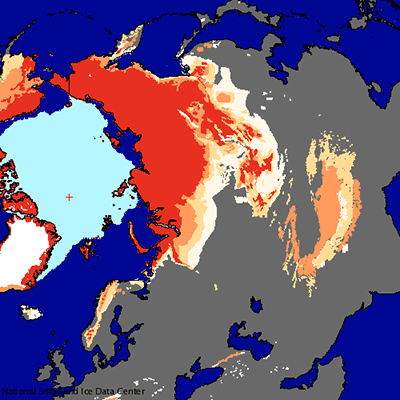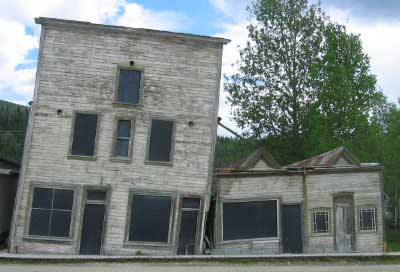The scientific definition of permafrost is: “a soil staying at or below 0 °C for more than two years”. The annual average temperature is the most important factor for permafrost existence. In regions covered by permafrost, only the upper 30 to 100 cm of soils (called the active layer) thaws every summer and then completely refreezes during the winter. The thickness of permafrost varies from a few meters to more than 150 meters.
Permafrost typically forms in regions with a mean annual air temperature of less than 0°C. Exceptions are found in moist-wintered forest climates, such as in Northern Scandinavia and North-Eastern Russia west of the Urals, where snow acts as an insulating blanket. The permafrost currently covers 20% of Earth’s land surface (25 million km²) and 25% of the Northern Hemisphere. The extension of the permafrost in Asia is very important (see illustration below).

Permafrost extent in the Northern Hemisphere - Source: UNEP

Permafrost extent in Asia (from deep permafrost in red to shallow
permafrost in light red) - Source: Atlas of the Cryosphere
What is happening to the permafrost?
The long-term records of the near-surface permafrost temperature, obtained from different parts of the permafrost zone in Northern regions, have shown a significant warming trend during the last 30 years. Ground temperature trends generally follow the air temperature trends with a more pronounced warming in the lower latitudes (between 55° and 65° North). But the permafrost belt stretching across Siberia to Alaska and Canada (the continental land mass surrounding the Arctic) could start thawing out 3 times faster than expected regarding the speed at which Arctic Sea ice is disappearing. The smaller the area of sea ice, the less sunlight is reflected and the more heat is absorbed.
What are the consequences of thawing?
Increasing permafrost temperatures changes many of its physical properties which has some negative effects on man-made infrastructures.
The thaw of the permafrost can also endanger the region's biodiversity. Indeed, permafrost controls plant communities and biomass production by soil temperature, active layer thickness, moisture content, presence of unfrozen water, and surface hydrology. The current changes in the permafrost thermal regime and active layer thickness affect plant diversity and biomass in all the regions covered by this layer of frozen soil.
Long-term permafrost degradation will also continuously improve conditions for the subsurface water drainage (especially in sandy soils) that will lead to increased dryness of soils, inducing significant vegetation stress. Improved drainage conditions will also lead to the reducing of numerous ponds within the degrading permafrost area dramatically affecting aquatic ecosystems.
And, last but not least, the thawing of the Arctic permafrost could dramatically worsen global warming by releasing massive amounts of trapped greenhouse gases, especially methane.

Drew Point, 2004. Coastal erosion of mud-rich permafrost along Beaufort Sea coastline. Cliff height is 3–4 m. Waves undercut permafrost and cause block slumping (center of photo). Source: USGS

Thawing permafrost is making this building lean in Dawson, Yukon.
Source: University of Iowa, Department of Geoscience
The release of methane as a consequence of thawing permafrost
From the ocean floor
It's always been a disturbing what-if scenario for climate researchers: gas hydrates stored in the Arctic Ocean floor (hard clumps of ice and methane, conserved by freezing temperatures and high pressure) could grow unstable and release massive amounts of methane into the atmosphere.
Since methane is a greenhouse gas more than 20 times more powerful than carbon dioxide, the result would be a drastic acceleration of global warming. Until now this idea was mostly academic; scientists had warned that such a thing could happen. Now it seems more likely that it will.
Russian polar scientists have shown strong evidence that the first stages of thawing are underway. They've studied the largest shelf sea in the world, off the coast of Siberia. In the permafrost bottom of the 200-meter-deep sea, enormous stores of gas hydrates lie dormant in mighty frozen layers of sediment. The carbon content of the ice-and-methane mixture here is estimated at 540 billion tons. This submarine hydrate was considered stable until now but the permafrost has grown porous and the shelf sea has already become "a source of methane passing into the atmosphere".
If this Siberian permafrost-seal thaws completely and all the stored gas escapes, the methane content of the planet's atmosphere would increase twelve fold and the result would be catastrophic global warming.
Russian scientists gathered evidence for the loss of rigour in the frozen sea floor in a measuring campaign during the Siberian summer. The seawater proved to be highly oversaturated with solute methane. In the air over the sea, greenhouse-gas content was measured in some places at 5 times normal values. In helicopter flights over the delta of the Lena River, higher methane concentrations have been measured at altitudes as high as 1,800 meters.
From the lakes
A recent study of two Siberian thaw lakes has revealed the Northern wetlands are a much larger source of methane release into the atmosphere than previously believed. Understanding the contribution of North Siberia thaw lakes to global atmospheric methane concentration is critical because the concentration of that potent greenhouse gas, which is highest at that latitude, has risen sharply in recent decades and exhibits a significant seasonal jump at those high northern latitudes.
The study has shown that the thawing permafrost along the margins of the thaw lakes (which comprise 90 % of the lakes in the Russian permafrost zone) is the primary source of methane released in the region. An isotopic analysis to determine the methane's age and origin coupled with measurements of the methane bubbles' composition has also shown that an expansion of these lakes between 1974 and 2000, a period of regional warming, increased methane emissions by 58%. Because the methane now emitted in this study region dates from the Pleistocene age, it's clear that the global warming has led to the release of old carbon stocks once stored in the permafrost.
Sources
Arctic thaw threatens Siberian permafrost
A Storehouse of Greenhouse Gases Is Opening in Siberia
How rapidly is permafrost changing and what are the impacts of these changes?
Geological survey of Canada
Greenhouse Gas Bubbling from Melting Permafrost Feeds Climate Warming at Much Higher Than Expected Rates
Wikipedia
Links
All about Frozen grounds - The National Snow and Ice Data Center
Frozen Grounds - Global Outlook for Ice and Snow - UNEP
Spring Thaw on North Slope and Frozen Ground: An Interview with Permafrost Expert
This page was written in 2009, as additional information to the poster series "10 years of Imaging the Earth"